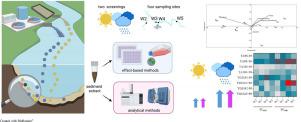Water Research ( IF 12.8 ) Pub Date : 2021-12-02 , DOI: 10.1016/j.watres.2021.117921 Aliaksandra Shuliakevich 1 , Melis Muz 2 , Jörg Oehlmann 3 , Laura Nagengast 4 , Katja Schröder 4 , Yvonne Wolf 4 , Ira Brückner 5 , Riccardo Massei 6 , Werner Brack 7 , Henner Hollert 1 , Sabrina Schiwy 1

|
Wastewater treatment plant effluents and releases from rainwater overflow basins can contribute to the input of genotoxic micropollutants in aquatic ecosystems. Predominantly lipophilic genotoxic compounds tend to sorb to particulate matter, making sediment a source and a sink of pollution. Therefore, the present study aims to investigate the genotoxic potential of freshwater sediments (i) during the dry period and (ii) after extensive rain events by collecting sediment samples in one small anthropogenically impacted river in Germany up- and downstream of the local wastewater treatment plant. The Micronucleus and Ames fluctuation assays with Salmonella typhimurium strains TA98, TA100, YG1041, and YG1042 were used to assess the genotoxic potential of organic sediment extracts. For evaluation of possible genotoxicity drivers, target analysis for 168 chemical compounds was performed.
No clastogenic effects were observed, while the genotoxic potential was observed at all sampling sites primarily driven by polycyclic aromatic hydrocarbons, nitroarenes, aromatic amines, and polycyclic heteroarenes. Freshwater sediments' genotoxic potential increased after extensive rain events due to sediment perturbation and the rainwater overflow basin release. In the present study, the rainwater overflow basin was a significant source for particle-bound pollutants from untreated wastewater, suggesting its role as a possible source of genotoxic potential. The present study showed high sensitivity and applicability of the bacterial Salmonella typhimurium strains YG1041 and YG1042 to organic sediment extracts to assess the different classes of genotoxic compounds. A combination of effect-based methods and a chemical analysis was shown as a suitable tool for a genotoxic assessment of freshwater sediments.
中文翻译:

评估大雨事件后淡水沉积物的遗传毒性潜力——从德国以污水为主的河流案例研究中的经验教训
污水处理厂的污水和雨水溢流池的排放会导致遗传毒性微污染物进入水生生态系统。主要是亲脂性遗传毒性化合物倾向于吸附到颗粒物质上,使沉积物成为污染源和汇。因此,本研究旨在通过在德国一条受人为影响的小型河流中收集沉积物样本,调查淡水沉积物 (i) 在干旱时期和 (ii) 在大雨事件后的遗传毒性潜力。植物。鼠伤寒沙门氏菌的微核和艾姆斯波动分析菌株 TA98、TA100、YG1041 和 YG1042 用于评估有机沉积物提取物的遗传毒性潜力。为了评估可能的遗传毒性驱动因素,对 168 种化合物进行了目标分析。
未观察到致断裂效应,而在所有采样点均观察到遗传毒性潜力,主要由多环芳烃、硝基芳烃、芳胺和多环杂芳烃驱动。由于沉积物扰动和雨水溢流池释放,在大范围降雨事件后淡水沉积物的遗传毒性潜力增加。在本研究中,雨水溢流池是未经处理的废水中颗粒结合污染物的重要来源,表明其可能是潜在的遗传毒性来源。本研究表明细菌鼠伤寒沙门氏菌的高灵敏度和适用性将菌株 YG1041 和 YG1042 用于有机沉积物提取物以评估不同类别的遗传毒性化合物。基于效应的方法和化学分析的组合被证明是淡水沉积物遗传毒性评估的合适工具。



























 京公网安备 11010802027423号
京公网安备 11010802027423号